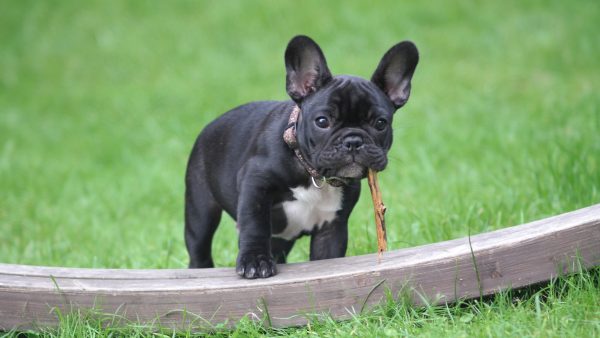The French bulldog is now the second most popular breed in America. Their cute features, portable size, and physical features make for a dog that can easily travel and doesn’t require a lot of exercise. “At around 20 pounds and perfectly sized for carry-on luggage, Frenchies have been marketed as the dog best suited to the lifestyles of the rich and quite possibly lazy,” writes Tove K. Danovich. “Rather than requiring human owners to change their lives to accommodate a new dog, the French bulldog is a breed that’s been broken to accommodate us.”

Historically, dogs were bred for functional reasons, not aesthetics. But evaluating a breed based on how they accomplish a task is tricky, leading to the rise of visual standards more easily judged. As breed standards were formalized, purebred dogs grew in popularity and became a luxury of sorts; but with a limited genetic pool, this popularity naturally led to a lot of inbreeding to maintain breed consistency.
Dog breeding is primarily is done to suit human owners, often at the expense of their animal companion’s health. But, in defense of would-be dog owners: people also face a significant challenge when picking pets that will suit their family — a breed is more of a known quantity, with somewhat predictable personality traits. Dog seekers have to take a leap of sorts, trusting their pick will work out. Perhaps there’s a better way to go about selecting dogs, like sorting more by behavior (like we used to do) and less by how they look. Meanwhile, too, some breeders are working to make healthier versions of existing breeds, like breeding bulldogs with longer snouts and thus fewer breathing issues.
Per Danovich’s Vox article: “We buy pet clothes and toys and grieve deeply when the dogs, with their shortened lives, inevitably leave us. People with purebred or designer dogs care about dogs for the same reason most humans do: They’re always there for us. The question is whether by treating dogs as commodities, we’re there for them, too.”




Comments (8)
Share
There are lots of related topics that I’m surprised that you didn’t bring up about dog breeds and the greater pet dog market. Such as how increasingly small dogs are being brought up from the US South and Puerto Rico to be adopted by middle and upper class pet owners in the Northeast because of the trend towards, “Adopt, don’t shop.” But Northeast shelters are still filled with dogs, namely pit bulls, which are unfashionable because of both their association with poor people and crime, and their unfairly garnered reputation as a breed that uniformly is aggressive and unsafe.
There’s also the issue of breed specific legislation, which is kind of wild as you mentioned in the podcast that breeds are based on visual aesthetics, so how can one or several breeds be labeled as dangerous when temperament isn’t visually apparent?
Beauty is in the eye of the beholder and this beholder thinks these creatures are anything but cute. They’re vile, quite frankly.
Anyway, it is better to adopt from a local shelter. Rather than buy inbred, unhealthy and immorally produced animals from breeders.
The breed “Standard” is not purely an aesthetic choice. The “standard” is based on the function or job the dog is used for. As an example, not any dog who retrieves makes a good bird dog regardless of what size it is or if it is slobbery or not. A Golden Retriever needs to be big enough to carry a goose, it needs to have a long enough neck to be able to swim with the goose in its mouth. Its muzzle needs to broad enough and long enough to hold the goose securely. It needs to have a “stop” so it can see above the goose when running or swimming. It eye needs closely fitted lids to protect the eyes when running through tall grasses. And that is just the head of a retriever. Not to mention, the dog cannot be slobbery as that would be problematic to the bird it is carrying.
Furthermore, showing in “dog shows” is just a small part of the “dog fancy.” All breeds can compete in “companion events” including obedience, rally obedience, agility, tracking, barn hunts, lure coursing, sent work and others (mixed breed dogs can also compete in these events). Then groups of dog breeds can compete in “performance events” that test for the skills the breeds were originally bred for such as herding trials for herding breeds, carting events for breeds like the Bernese Mountain Dog, field trials and hunt tests for gun dog breeds.
The point of getting a pure bred dog is its predictability. Are there tons of crappy breeders who produce dogs who do not look or act like the breed “standard”? Of course there are, but those people are not actually a part of the “Dog Fancy” a group which by its very definition is those people who compete with their dogs. It is also not the fault of the “Dog Fancy” that most people do so little research before they get their dog. I currently have my fifth Golden Retriever. They have all acted exactly like the stereo-type of the Golden Retriever (friendly, active, smart and trainable) and have lived to be at least 12 years old. I lucked out with one of them, but with the others I did my research and I got what I expected.
Finally, as to cancer and Goldens. You will find that the “Golden Fancy” is the group that is most concerned with solving the problem and as a whole through the Golden Retriever Club of America’s Golden Retriever Foundation has donated millions of dollars to research cancers in our breed. Furthermore, although the majority of Goldens will die from cancer, their average lifespan is not any shorter than any other breed of a similar size. Therefore on average they are not dying younger than other breeds but that while other breeds like Dobermans die of things like Degenerative Myelopathy, Dilated Cardiomyopathy and Cancers with an average lifespan of 10 years, a Golden will die of a cancer with an average life span of 10 years.
As another commenter said, you left out the big business of small dog adoption and the small problem of the lack of large dog adoption (not only driven by social stigma of poor people: A smaller dog is often just easier to handle, and fits in a small apartment or house better. It can also need less exercise) and also the question of dog racing and the meat-grinder of greyhound breeding. This is not just a yank problem either. Australian dog shelters are full of larger breeds that outgrew their owners ability to take care of them, and greyhounds often get a death sentence if they aren’t as fast as their litter mates.
Then there’s drift. Personally I loved the ~200 year old paintings of pugs, and wanted one of my own. Then I saw a modern pug, was disgusted, and never wanted a pug again. I have no idea why the two types of dog even have the same name, the historical pugs don’t look anything like a modern pug, they don’t even have the same colour, let alone the same nose.
It’s not a dogs life any more.
I was really disappointed in this episode. It presents a really incomplete picture of ways to acquire dogs. It spends a lot of time discussing breeding dogs for appearance in a negative way, but never brings up breeding for behavior. With an increase in population density, there is an increase in demand for small, non shedding, easy going dogs that are social with people and dogs. Dogs have always been bred to fit the needs of a time and place. There is nothing wrong with breeding dogs to suit the needs of 21st century city dwellers, particularly when there is a dog shortage so severe we are importing dogs by the planeful from overseas.
Ummm french bull dogs and any animal that has been selectively bred with these kinds of mutations are anything but natural…
A comment about the position that pit bulls are “unfairly” considered to be aggressive. Most working breeds have been bred for specific behaviors. Retrievers are bred to love water (even icy water), retrieving, but also sitting for hours without running around, watching and waiting for the ducks to come in. Pointers tend to be busy, inquisitive and wanting to search, wanting to course over fields and thickets searching for the smell of a bird. Often with a working dog, their training may be marginally successful until it seems they get the software delivered. My brother’s last pointer would not point, had not a clue about what she was supposed to do despite extensive field training. The breeder said, don’t worry, it will come. And at about a year it was if a switch had been thrown or a software upgrade was delivered, and, bam, a perfect point from then on. So my question about pit bulls is what going on with sudden attacks, that their software is suddenly turned on? They were bred to fight, and that heritage IS in them, just as herding is built into Australian shepard breeds.
In UK there is a sort of fight back against appearance being everything. If I were buying a labrador or a spaniel I would look for one from Working Stock. Dogs that are to work as gun dogs (bird dogs in the US?) will be bred first for temperament and ability!